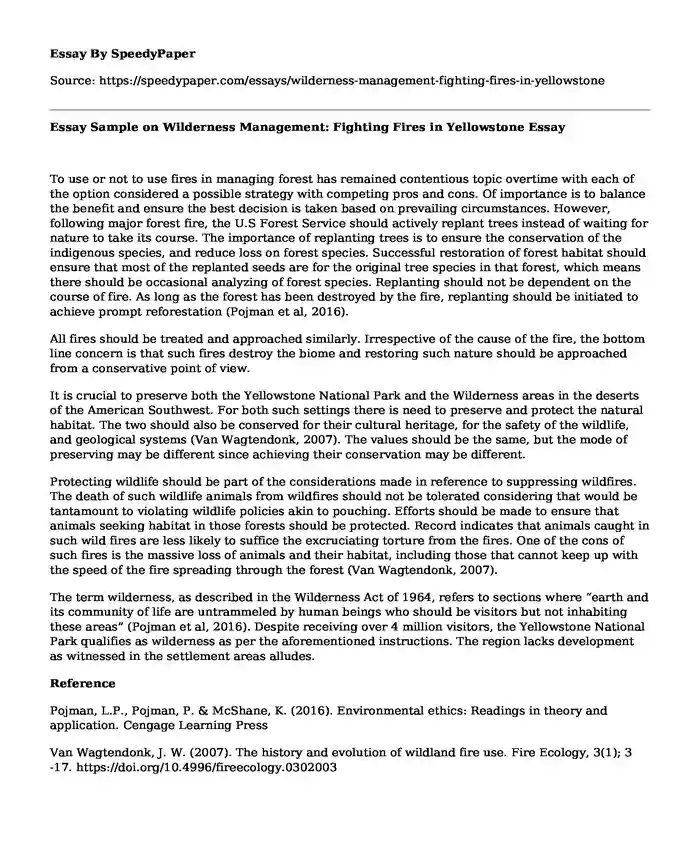
| Type of paper: | Essay |
| Categories: | Management Nature Disaster |
| Pages: | 2 |
| Wordcount: | 483 words |
To use or not to use fires in managing forest has remained contentious topic overtime with each of the option considered a possible strategy with competing pros and cons. Of importance is to balance the benefit and ensure the best decision is taken based on prevailing circumstances. However, following major forest fire, the U.S Forest Service should actively replant trees instead of waiting for nature to take its course. The importance of replanting trees is to ensure the conservation of the indigenous species, and reduce loss on forest species. Successful restoration of forest habitat should ensure that most of the replanted seeds are for the original tree species in that forest, which means there should be occasional analyzing of forest species. Replanting should not be dependent on the course of fire. As long as the forest has been destroyed by the fire, replanting should be initiated to achieve prompt reforestation (Pojman et al, 2016).
All fires should be treated and approached similarly. Irrespective of the cause of the fire, the bottom line concern is that such fires destroy the biome and restoring such nature should be approached from a conservative point of view.
It is crucial to preserve both the Yellowstone National Park and the Wilderness areas in the deserts of the American Southwest. For both such settings there is need to preserve and protect the natural habitat. The two should also be conserved for their cultural heritage, for the safety of the wildlife, and geological systems (Van Wagtendonk, 2007). The values should be the same, but the mode of preserving may be different since achieving their conservation may be different.
Protecting wildlife should be part of the considerations made in reference to suppressing wildfires. The death of such wildlife animals from wildfires should not be tolerated considering that would be tantamount to violating wildlife policies akin to pouching. Efforts should be made to ensure that animals seeking habitat in those forests should be protected. Record indicates that animals caught in such wild fires are less likely to suffice the excruciating torture from the fires. One of the cons of such fires is the massive loss of animals and their habitat, including those that cannot keep up with the speed of the fire spreading through the forest (Van Wagtendonk, 2007).
The term wilderness, as described in the Wilderness Act of 1964, refers to sections where “earth and its community of life are untrammeled by human beings who should be visitors but not inhabiting these areas” (Pojman et al, 2016). Despite receiving over 4 million visitors, the Yellowstone National Park qualifies as wilderness as per the aforementioned instructions. The region lacks development as witnessed in the settlement areas alludes.
Reference
Pojman, L.P., Pojman, P. & McShane, K. (2016). Environmental ethics: Readings in theory and application. Cengage Learning Press
Van Wagtendonk, J. W. (2007). The history and evolution of wildland fire use. Fire Ecology, 3(1); 3 -17. https://doi.org/10.4996/fireecology.0302003
Cite this page
Essay Sample on Wilderness Management: Fighting Fires in Yellowstone. (2024, Jan 06). Retrieved from https://speedypaper.net/essays/wilderness-management-fighting-fires-in-yellowstone
Request Removal
If you are the original author of this essay and no longer wish to have it published on the SpeedyPaper website, please click below to request its removal:
- Dogs Are Better Than Cats Essay | Free Paper Example for Everyone
- The Risk Assessment Plan, Free Essay for You
- Essay Sample on McDonald's Stock Management System
- Essay Example: Concise Description of the Project
- Free Essay Sample on Time Management Skills and Time Distractors
- Navigating Workplace Dynamics: Insights from an Interview with a Successful Manager - Report Example
- Paper Sample on Risk Management Division and Technology
Popular categories




